Carboxylic Acid & ITs Derivatives: Carboxylic acids are organic compounds which contain carboxylic group -COOH.
The name carboxyl is derived from two words, i.e. carbonyl and hydroxyl because in carboxylic acid both carbonyl and hydroxyl groups are directly linked to each other.
Carboxylic acids are classified in accordance to the number of –COOH groups present in the molecule.

Carboxylic acids are further classified as aliphatic and aromatic. In aromatic, the carboxylic group is attached to aryl group.
Monocarboxylic acid of aliphatic species are commonly known as fatty acid, containing more than twelve carbon atoms, obtained from fats.
General Methods of Preparation
From Alcohols
Oxidation of Alcohol: Primary alcohols on oxidation forms monocarboxylic acid with same number of carbon atoms. The oxidation can be carried out in presence of potassium dichromate and dilute sulphuric acid. The initial product of oxidation is the corresponding aldehyde which then forms acid.

In case alkaline KMnO₄ is used as an oxidizing agent, the aldehyde undergoes oxidation more rapidly than primary alcohol.
The selective oxidation is possible in presence of CrO₃ and H₂SO₄ in acetone. It does not affect C=C and >C=C< but selectively oxidizes hydroxyl group to COOH.

- From Alkene
(i) Oxidative cleavage: Alkene can be oxidized into corresponding carboxylic acid with hot alkaline KMnO₄.
CH₂=CH₂ + alkaline KMnO₄ → 2HCOOH
CH₃CH=CHCH₃ + KMnO₄ + H⁺ → CH₃COOH + CH₃COOH
(ii) Carbonylation: (Koch reaction): When a mixture of alkene, carbon monoxide and steam is heated under pressure at 350°C in presence of phosphoric acid, monocarboxylic acid is formed.
CH₂=CH₂ + CO + H₂O → CH₃CH₂COOH
- From Alkyne
CH≡CH + KMnO₄ + H₃O⁺ + H₂O → 2HCOOH
R–C≡C–R' + 3[O] + H₃O⁺ → RCOOH + R'COOH
On oxidation with chromic acid (K₂CrO₄ + H₂SO₄) single carboxylic acid is formed
CH≡CH + H₂O + [O] → CH₃COOH (chromic acid)
CH₃–C≡CH + H₂O + [O] → CH₃CH₂COOH
By Carbonation of Grignard Reagents
Grignard reagent on treatment with carbon dioxide forms a addition product, which on hydrolysis gives acid.

Hydrolysis of Trihalogen Derivatives
Trihalogen derivatives of alkanes in which all the three halogen atoms are attached to same carbon atom, on hydrolysis with aqueous alkali solution, form mono carboxylic acids

Heating Sodium Alkoxide with Carbon Monoxide

Hydrolysis of Acid Derivatives
- (i) From ester:
R–COOR' + H–OH → R–COOH + R'–OH
- (ii) From acid amide:
R–CONH₂ + H–OH → R–COOH + NH₃ (alkali or acid)
- (iii) From anhydrides:
(RCO)₂O + H–OH → 2R–COOH
- (iv) From acid halide:
R–COX + H–OH → R–COOH + H–X
By Hydrolysis of Alkane Nitrile
The compound containing CN group can be hydrolysed to carboxylic acid with an additional carbon atom than original alkyl halide.
![]()
Exercise 1: The most appropriate reagent for the conversion of 2-pentanone to butanoic acid is
(A) NaOI; H₃O⁺
(B) KMnO₄, NaOH, H₃O⁺
(C) K₂Cr₂O₇, H₂SO₄
(D) AgOH, NH₄OH; H₃O⁺
Illustration 1: On reaction with dry ice ethyl magnesium bromide followed by hydrolysis gives
(A) methanoic acid (B) ethanoic acid (C) propanoic acid (D) methane
Solution: (C)

PHYSICAL PROPERTIES
- The lower fatty acids upto C₁₀ are colourless liquids. The higher ones are waxy solids.
- The molecules of carboxylic acid are polar in nature and exhibit hydrogen bonding.
- The lower members are highly soluble in water but the solubility decreases with the rise of molecular mass. The acids above C₁₀ carbon are insoluble in water. It is due to its polar nature and tendency to form H-bond.
- Boiling point of carboxylic acids increase regularly with increase in molecular mass. Boiling points of acid are higher than alcohol and ether. This is due to intermolecular hydrogen bonding between acid molecules. It exists in dimeric form

CHEMICAL PROPERTIES
The reactions of carboxylic acid can be studied under four different categories:

Reaction involving Alkyl Group
α-hydrogen atom undergoes substitution due to presence of electronegative carbonyl group
α-halogenation of acid (Hell Volhard Zelinski Reaction):

Direct iodination can be done in the presence of an oxidizing agent like iodic acid or mercuric oxide.

Note: Tertiary acids show no substitution due to absence of α-hydrogen
Oxidation
Monocarboxylic acids except formic acid are resistant to oxidation. But at higher temperature it oxidizes into carbon dioxide and water.
HCOOH + ½O₂ → CO₂ + H₂O
In presence of H₂O₂ and Ag₂O, it is oxidized to α-hydroxy acid.

Reaction Involving Carboxyl Group
- Salt formation:
Carboxylic acids are weak acids and their carboxylate ions are strong conjugated bases. They are slightly alkaline due to hydrolysis of carboxylate ions. The order of acidity and basicity of corresponding conjugated bases are follows:
Acidity:RCOOH > HOH > R-OH > CH≡CH > NH₃ > RH
Basicity:R⁻COO⁻ < OH⁻ < RO⁻ < CH≡C⁻ < NH₂⁻ < R⁻
Carboxylic acids react with metal to liberate hydrogen. It is soluble in both NaOH and NaHCO₃ solution.
2CH₃COOH + 2Na → 2CH₃COONa + H₂
CH₃COOH + NaOH → CH₃COONa + H₂O
CH₃COOH + NaHCO₃ → CH₃COONa + H₂O + CO₂
Acidity of carboxylic acids
The strength of an acid depends on the ability of acid to lose proton. When dissolved in water it is expressed in terms of dissociation constant (Kₐ)
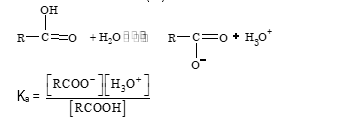
Acid strength ∝ Kₐ value ∝ 1/pKₐ value
- Cause of acidic nature:
The acidity of carboxylic acid is due to resonance stabilization of its anion.

Due to electron deficiency on oxygen atom of the hydroxyl group (structure – II), there is displacement of electron pair of O–H bond towards oxygen atom. This help in release of hydrogen as proton. The resulting carboxylate ion is also stabilized by resonance as resonance energy of the carboxylate ion is much higher than that of undissociated acid.

-
Effect of substitution on acidity
- Acidic strength ∝ -I effect (electron withdrawing group)
- Acidic strength ∝ 1/+I effect
- Increase in distance of halogen atoms from COOH group decreases acidity.
- Increase in electronegativity of halogen atoms increases the acidity.
-
Effect of electron withdrawing groups (-I effect):
(i) An electron withdrawing group stabilizes the anion by dispersing the negative charge and therefore increases acidity.
Cl₃C–COOH > Cl₂CH–COOH > Cl-CH₂COOH > CH₃COOH
(ii) CH₃CH₂CHClCOOH > CH₃CHClCH₂COOH > ClCH₂CH₂CH₂COOH
(iii) F–CH₂COOH > BrCH₂COOH > ICH₂COOH
-
Effect of electron releasing group (+I effect):
Electron releasing group increase electron density on oxygen atom resulting decrease in stability and decrease acidic strength.
H–COOH > C₆H₅–COOH > CH₃–COOH > (CH₃)₂CH–COOH > (CH₃)₃C–COOH
Exercise 2: Consider the following compounds with regard to their acidities.

The correct order of decreasing acidity of these compounds is
(A) IV > III > I > II
(B) III > IV > I > II
(C) IV > III > II > I
(D) II > I > III > IV
Illustration 2: Among the compounds
I. CH₃COOH II. CH₃CH₂COOH III. CH₂=CHCOOH IV. HC≡C-COOH
the correct order of decreasing acidity is
(A) I > II > III > IV
(B) IV > III > II > I
(C) IV > III > I > II
(D) III > IV > I > II
Solution: (C) More the 's' character of the C adjacent to COOH group, more will be the electronegativity of that carbon and hence more will be the acidity.
- Reaction with ketene
R–COOH + CH₂=C=O → R–CO-O-CO-CH₃ (Anhydride)
- Reaction with diazomethane
R–COOH + CH₂N₂ → R–COOCH₃ + N₂
Reactions Involving Replacement of OH
-
Formation of acid halide
CH₃COOH + PCl₅ → CH₃COCl + HCl + POCl₃
3CH₃COOH + PCl₃ → 3CH₃COCl + H₃PO₃
CH₃COOH + SOCl₂ → CH₃COCl + SO₂ + HCl
- Reaction with alcohol (esterification)
CH₃COOH + CH₃OH ⇌ CH₃COOCH₃ + H₂O (H₂SO₄)

This reaction is reversible and reaches equilibrium when there are enough amount of reactant & product.
Exercise 3 - The rate of acid catalysed esterification of the carboxylic acids
I. CH₃COOH II. CH₃CH₂CH₂COOH III. (CH₃)₂CCOOH IV. C₆H₅CCOOH
with methanol decreases in the order
(A) I > II > III > IV
(B) IV > III > II > I
(C) III > I > II > IV
(D) II > III > IV > I
- Reaction with ammonia
CH₃COOH + NH₃ → CH₃COONH₄ → CH₃CONH₂
(Ammonium acetate → Acetamide)
- Reaction with P₂O₅
2CH₃COOH + P₂O₅ → (CH₃CO)₂O + H₂O (anhydride)
- Reduction
The COOH group is reduced to CH₂OH group in presence of LiAlH₄.
With LiAlH₄ the –COOH is reduced to –CH₂–OH.
On heating with HI & red P, product is alkane
Catalytic reduction gives alkane
R–COOH + LiAlH₄ → R–CH₂–OH + H₂O
In presence of red phosphorus at 200°C, COOH group is reduced to alkane.
R–COOH + 6HI + red P → R–CH₃ + 2H₂O + 3I₂ (200°C)
The product is again alkane when COOH group is catalytically reduced in presence of Ni.
R–COOH + 3H₂ → R–CH₃ + 2H₂O (Ni)
Illustration 3: Propanoic acid → PCl₅ → X → C₆H₆/AlCl₃ → Y
In above sequence Y is
(A) phenyl ethyl ketone (B) phenyl acetate (C) ethyl benzene (D) ethyl benzoate
Solution: (A)
CH₃–CH₂–COOH → CH₃–CH₂–COCl → C₆H₅–CO–CH₂–CH₃
(Friedel Craft reaction)
Reaction Involving COOH as a Whole
- Decarboxylation
It is a process of elimination of CO₂ from a salt of carboxylic acid, in presence of soda lime and the product is alkane.
R–COONa + NaOH/CaO → R–H + Na₂CO₃
Dibasic acids with two –COOH groups on same carbon atom will loose a molecule of CO₂ on simple heating.
R–C(COOH)₂ → R–COOH + CO₂
Decarboxylation of β-keto acids will take place with warm dil. H₂SO₄ to form aldehyde.
CH₃–CO–CH₂–COOH → CH₃–CO–CH₃ + CO₂ (dil. H₂SO₄)
- Hunsdiecker reaction
An alkyl halide is formed when the silver salt of carboxylic is heated with halogen
CH₃–COOAg + Br₂ → CH₃–Br + AgBr + CO₂ (CCl₄)
A carboxyl radical is produced in a two-step process:
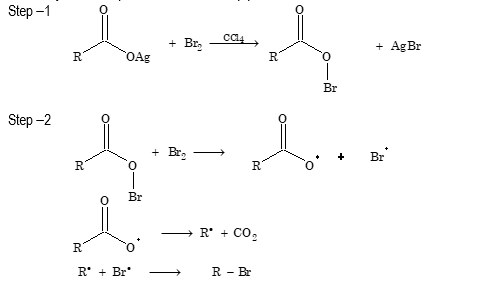
- Formation of amine (Schmidt reaction)
Primary amine containing one carbon atom less than the acid are formed when monocarboxylic acid react with hydrazoic acid (N₃H) in presence of concentration H₂SO₄.

-
Dry distillation of acid (Heating of calcium salt of acid)
When calcium salt of fatty acids other than calcium formate are heated, ketones are formed. When calcium formate is heated, formaldehyde is formed. When a mixture of calcium salt of a fatty acids and calcium formate is heated, aldehyde is formed.
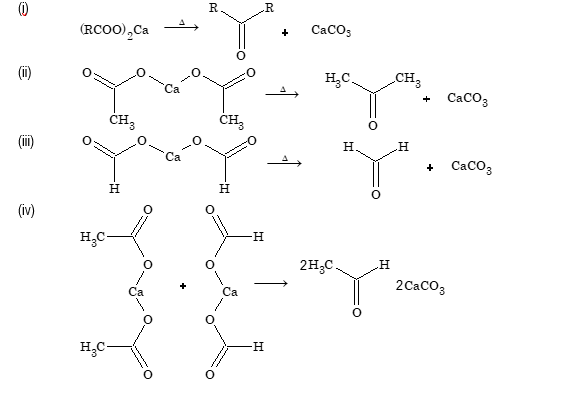
Reaction Chart of Acetic Acid
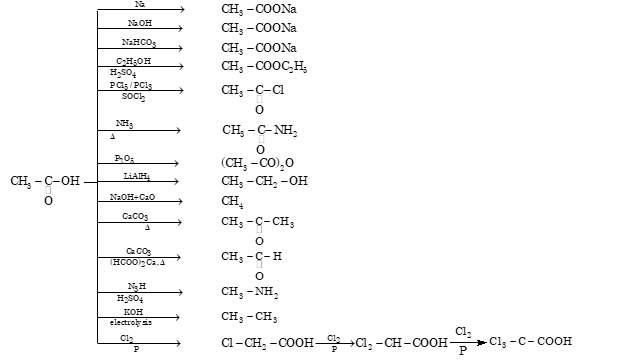
Identification Test
| Test | Acetic acid | Formic acid |
|---|---|---|
| 1. Tollens reagent | Unaffected | Gives silver mirror or black ppt. HCOOH + Ag₂O → 2Ag + CO₂ + H₂O |
| 2. Fehling solution | Unaffected | Gives red ppt. HCOOH + 2CuO → Cu₂O + CO₂ + H₃O |
| 3. Mercuric chloride | Unaffected | Form white ppt. which change to Greyish black. HgCl₂ → Hg₂Cl₂ → 2Hg |
| 4. Acidic KMnO₄ | Unaffected | Decolourize |
| 5. Acid + NaHSO₃ + Sodium nitroprusside | Unaffected | Greenish blue colour |
| 6. Acid + FeCl₃ | Wine red | Red colour which changes to brown ppt. on heating |
Exercise 4 - Consider the following sequence of reaction
CHO-CHO + HCN (excess) + H₂O → A → B (heat)
The product (B) is
(A) lactic acid
(B) oxalic acid
(C) tartaric acid
(D) succinic acid
Illustration 4: Which of the following reactions does not involve decarboxylation?
(A) CH₃COOAg + Br₂ → (Heat, CCl₄)
(B) CH₃COCH₂CH₃COOH + Br₂ → (Heat)
(C) CH₃COO⁻ → (anodic oxidation)
(D) CH₃CH₂COOH + Br₂ + P → (Heat)
Solution: (D) In (D), the hydrogen will be substituted by Br.
ACID DERIVATIVES
The classes of compounds obtained from acids by the replacement of –OH group of –COOH group with –X, -NH₂, -OOCR or –OR are termed as acid derivatives
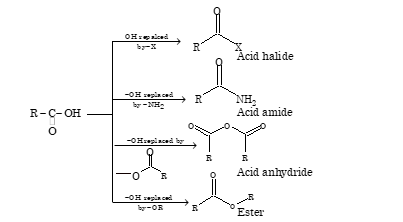
Acyl derivatives are characterized by nucleophilic substitution reactions.
R-CO-L + Nu⁻ → R-CO-Nu + L⁻
(L = leaving group)
ACETYL CHLORIDE
- Method of Preparation
Acetyl chloride is prepared by heating acetic acid with phosphorous trichloride, phosphorus pentachloride or thionyl chloride. Thionyl chloride is the best reagent because the byproducts are in gaseous forms, which are easily separated.
(i) CH₃COOH + PCl₅ → CH₃COCl + HCl + POCl₃
(ii) 3CH₃COOH + PCl₃ → 3CH₃COCl + H₃PO₃
(iii) CH₃COOH + SOCl₂ → CH₃COCl + SO₂ + HCl
- Physical Properties
- It is a colourless liquid with a pungent odour.
- It is soluble in ether acetone and acetic acid.
- Chemical Properties
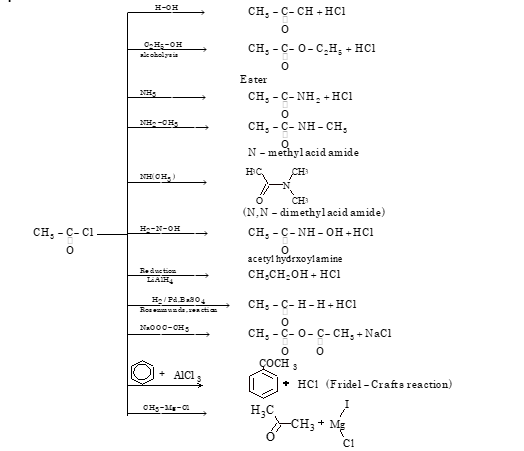
ACETIC ANHYDRIDE
- Methods of Preparation
1. It is prepared by heating glacial acetic acid with a dehydrating agent like P₂O₅ or anhydrous ZnCl₂.
2CH₃COOH + P₂O₅ → (CH₃CO)₂O + H₂O
2. Acetic anhydride is prepared by heating sodium salt of acid with acid halide.
CH₃COONa + CH₃COCl → (CH₃CO)₂O + NaCl
-
Physical Properties
- It is colourless, pungent smelling liquid. It boils at 139.5°C.
- It is sparingly soluble in water but soluble in ether, alcohol and acetic acid.
- Chemical Properties
The reactivity of anhydride is less than acid halide. One half of the acetic anhydride is used for acetylation while other half is converted into acetic acid.
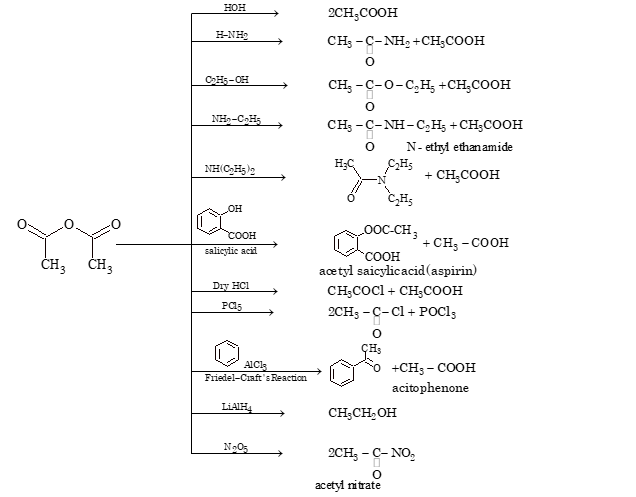
Illustration 5: The formula C₄H₄O₄ can represent
(A) A cyclic ester of dibasic acid
(B) A cis–dibasic acid
(C) A Trans dibasic acid
(D) All are correct
Solution: (D)
(A) Cyclic anhydride structure
(B) cis-butenedioic acid (maleic acid)
(C) trans-butenedioic acid (fumaric acid)
Exercise 5 Formyl chloride on reaction with hydrogen in presence of Pd/BaSO₄ gives
(A) Formaldehyde
(B) CO + HCl
(C) Methanol
(D) None
Exercise 6: Benzyl chloride can be prepared by treating benzoic acid with
(A) SO₂Cl₂
(B) SOCl₂
(C) Cl₂, hν
(D) Cl₂, H₂O
Illustration 6: Which of the following reagents is able to convert an alcohol into an alkyl chloride but is not able to convert a carboxylic acid into an acid chloride?
(A) PCl₃ (B) PCl₅ (C) SOCl₂ (D) HCl, ZnCl₂
Solution: (D)
ACETAMIDE
- Methods of Preparation
(i) Laboratory preparation:
Acetic acid on reaction with ammonia gives ammonium acetate, which on heating gives acetamide.
CH₃COOH + NH₃ → CH₃COONH₄ → CH₃CONH₂ + H₂O
(ii) By ammonolysis:
All acid derivatives on ammonolysis gives acetamide.
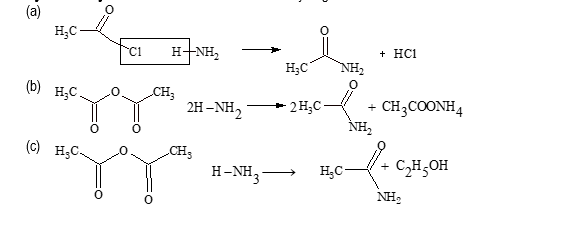
(iii) By partial hydrolysis of cyanide:
Alkyl cyanide on hydrolysis in presence of alkaline H₂O₂ or by dil. H₂SO₄ gives acetamide.
CH₃CN + H₂O₂ (alkaline) + H₂O → CH₃CONH₂
- Physical Properties
- Acetamide is a colourless crystalline solid, it is readily soluble in water and alcohol.
- It exist as a dimer due to hydrogen bonding
Chemical Properties
- (i) Hydrolysis:
Acetamide is hydrolysed by water, rapidly by acids and more rapidly by alkalies.
CH₃CONH₂ + H₂O → CH₃COOH + NH₃
CH₃CONH₂ + NaOH → CH₃COONa + NH₃
(iii) By partial hydrolysis of cyanide:
Acetamide behaves as an amphoteric compound i.e. it shows acidic as well as basic nature. It forms salt with acids and bases both.
CH₃CONH₂ + HCl(conc.) → CH₃CONH₂.HCl (Acetamide hydrochloride)
CH₃CONH₂ + Na (ether) → CH₃CONHNa + ½H₂ (Sodium acetamide)
(ii) Amphoteric nature:
Acetamide on reduction in presence of sodium and ethanol or ethereal solution of LiAlH₄ gives alkyl amine.
CH₃CONH₂ + 4H → CH₃CH₂NH₂ + H₂O (ether)
(iii) Dehydration:
When heated with P₂O₅ or POCl₃, it forms alkyl cyanide.
CH₃CONH₂ + P₂O₅ → CH₃CN + H₂O
(iv) Action of nitrous acid:
CH₃CONH₂ + H-NO₂ → CH₃COOH + N₂ + H₂O
(v) Action with PCl₅:
When heated with PCl₅, acetamide forms methyl cyanide
CH₃CONH₂ + PCl₅ → CH₃CN + POCl₃ + 2HCl
(vi) Hofmann bromide reaction or Hofmann degradation:
Amides when heated with bromine and caustic soda, yield primary amines containing one carbon atom less than amide.
CH₃CONH₂ + Br₂ + KOH → CH₃NH₂
ANSWER TO EXERCISES
| Exercise | Answer |
|---|---|
| Exercise 1 | A |
| Exercise 2 | B |
| Exercise 3 | A |
| Exercise 4 | C |
| Exercise 5 | B |
| Exercise 6 | B |
Frequently Asked Questions
Carboxylic acids form amides through several well-established synthetic pathways, each with specific advantages and applications in organic chemistry. Understanding these mechanisms is crucial for anyone working with organic synthesis or studying biochemical processes.
Direct Amidation Mechanisms
The most common method involves activating the carboxylic acid to make it more electrophilic. This typically requires coupling reagents like EDC (1-ethyl-3-(3-dimethylaminopropyl)carbodiimide), DCC (dicyclohexylcarbodiimide), or HATU (1-[bis(dimethylamino)methylene]-1H-1,2,3-triazolo[4,5-b]pyridinium 3-oxid hexafluorophosphate). These reagents convert the carboxylic acid into a reactive intermediate that readily couples with amines to form amides.
Key Point: Direct heating of carboxylic acids with amines is generally ineffective due to acid-base neutralization, which forms ammonium carboxylate salts rather than amides.
Step-by-Step Mechanism Using EDC Coupling
1. The carboxylic acid reacts with EDC to form an O-acylisourea intermediate
2. This activated ester is attacked by the amine nucleophile
3. The tetrahedral intermediate collapses, eliminating the urea byproduct
4. The final amide product is formed with excellent yields (typically 80-95%)
Alternative Synthetic Routes
For industrial applications, the acid chloride route is often preferred. Carboxylic acids are first converted to acid chlorides using reagents like thionyl chloride (SOCl₂) or oxalyl chloride. The resulting acid chlorides are highly reactive and readily form amides when treated with amines, though this method requires anhydrous conditions and careful temperature control.
Biological Significance
In biological systems, amide bond formation is catalyzed by enzymes like peptidyl transferase in ribosomes, where amino acids are coupled to form proteins. This process involves activated amino acid intermediates (aminoacyl-tRNAs) that undergo nucleophilic attack by the growing peptide chain.
Practical Considerations and Safety
When performing amide synthesis in the laboratory, several factors must be considered: reaction pH should be maintained between 7-8 for optimal coupling efficiency, water content must be minimized as it competes with amine nucleophiles, and temperature control is critical to prevent side reactions. Always use appropriate personal protective equipment, as many coupling reagents can cause skin and respiratory irritation.
The selective reduction of carboxylic acids to aldehydes represents one of the most challenging transformations in organic chemistry due to the tendency of aldehydes to be further reduced to primary alcohols. This selective reduction requires specialized reagents and carefully controlled conditions to achieve high yields and selectivity.
Rosenmund Reduction Method
The classical approach involves first converting the carboxylic acid to an acid chloride using thionyl chloride or oxalyl chloride, followed by hydrogenation over poisoned palladium catalyst (Pd/BaSO₄ with quinoline or sulfur compounds). This method provides excellent selectivity for aldehyde formation because the poisoned catalyst prevents over-reduction to alcohols.
Mechanism: The poisoned palladium catalyst selectively reduces the C=O bond in acid chlorides while preventing further reduction of the resulting aldehyde, achieving 70-90% yields under optimal conditions.
Modern DIBAL-H Approach
Diisobutylaluminum hydride (DIBAL-H) offers a more direct route, reducing carboxylic acids at low temperatures (-78°C to -60°C) in anhydrous solvents like toluene or dichloromethane. The key to success with DIBAL-H is precise stoichiometry (typically 1.2-1.5 equivalents) and temperature control to prevent over-reduction.
Step-by-Step DIBAL-H Procedure
1. Cool the carboxylic acid solution to -78°C under inert atmosphere
2. Add DIBAL-H dropwise to maintain temperature below -60°C
3. Monitor reaction progress by TLC or GC-MS
4. Quench carefully with methanol, then aqueous Rochelle's salt
5. Extract and purify the aldehyde immediately to prevent oxidation
Safety Alert: DIBAL-H is pyrophoric and reacts violently with water. Always handle under strict inert atmosphere conditions, use appropriate fire suppression equipment, and have emergency protocols in place.
Alternative Methods
For substrate-sensitive cases, borane-dimethyl sulfide complex can be used at controlled temperatures, while lithium tri-tert-butoxyaluminum hydride offers milder conditions suitable for compounds containing other reducible functional groups. Each method requires optimization based on substrate structure and desired selectivity.
Purification and Storage Considerations
Aldehydes are inherently unstable and prone to oxidation. Immediate purification using column chromatography under nitrogen atmosphere is recommended, followed by storage at low temperatures under inert gas. Addition of antioxidants like BHT can extend shelf life significantly.
Optimization Tip: For large-scale preparations, continuous addition of reducing agent while monitoring by online IR spectroscopy can provide real-time feedback for optimal conversion without over-reduction.
Understanding these reduction methods enables chemists to access aldehydes efficiently while maintaining synthetic flexibility and safety protocols essential for successful organic transformations.
Carboxylic acids participate in a diverse range of chemical reactions due to their unique structural features, including both acidic hydrogen and electrophilic carbonyl carbon. Understanding these reaction patterns is essential for organic synthesis, biochemistry, and industrial chemistry applications.
Acid-Base Reactions
As Brønsted-Lowry acids, carboxylic acids readily donate protons to bases, forming carboxylate salts. The pKa values typically range from 3-5 for simple aliphatic acids, making them significantly more acidic than alcohols (pKa ~15-16) due to resonance stabilization of the conjugate base. This property enables neutralization reactions with metals, metal oxides, and organic bases to form water-soluble salts.
Key Reactions: RCOOH + NaOH → RCOONa + H₂O (salt formation)
2RCOOH + Mg → (RCOO)₂Mg + H₂ (metal reaction)
Nucleophilic Acyl Substitution Reactions
The carbonyl carbon in carboxylic acids undergoes nucleophilic attack, though direct substitution is challenging due to the poor leaving ability of hydroxide. These reactions typically require activation through conversion to more reactive derivatives like acid chlorides, anhydrides, or activated esters.
Esterification: Fischer esterification with alcohols under acid catalysis forms esters. The mechanism involves protonation of carbonyl oxygen, nucleophilic attack by alcohol, and elimination of water through a tetrahedral intermediate.
Amidation: Direct reaction with amines requires coupling reagents or high temperatures. Industrial processes often use acid chloride intermediates for efficient amide bond formation.
Reduction Reactions
Carboxylic acids can be reduced to primary alcohols using strong reducing agents like lithium aluminum hydride (LiAlH₄). The mechanism involves formation of aluminum alkoxide intermediates, followed by hydrolysis to yield alcohols. Selective reduction to aldehydes requires specialized conditions and reagents like DIBAL-H at low temperatures.
Alpha-Hydrogen Reactions
Carboxylic acids with α-hydrogens undergo enolate chemistry, though less readily than ketones due to electron-withdrawing effects of the carboxyl group. The Hell-Volhard-Zelinsky reaction allows α-halogenation using phosphorus tribromide and bromine, proceeding through an acid bromide intermediate.
Mechanistic Insight: Enolate formation requires strong bases like LDA (lithium diisopropylamide) and proceeds through deprotonation α to the carbonyl, forming resonance-stabilized enolate ions.
Decarboxylation Reactions
Under specific conditions, carboxylic acids lose CO₂ to form alkanes or alkenes. β-Keto acids readily decarboxylate upon heating through a cyclic transition state, while simple carboxylic acids require harsh conditions or metal catalysts. This reaction is important in biological systems (citric acid cycle) and synthetic applications.
Oxidative Reactions
While carboxylic acids are already in a high oxidation state, they can undergo oxidative coupling reactions or be converted to higher oxidation state derivatives. The Kolbe electrolysis process couples two carboxylate anions to form alkanes with elimination of CO₂, while permanganate oxidation can cleave chains at carboxylic acid positions.
Reaction Conditions: Many carboxylic acid reactions require anhydrous conditions, controlled temperatures, and specific catalysts. Always consider substrate electronic and steric effects when predicting reactivity patterns.
These fundamental reaction types provide the foundation for complex organic transformations and enable the synthesis of diverse functional compounds from simple carboxylic acid starting materials.
The reaction between aniline and carboxylic acids represents a fascinating example of acid-base chemistry complicated by the aromatic nature of aniline and the potential for further synthetic transformations. Understanding this interaction is crucial for pharmaceutical synthesis, dye chemistry, and aromatic compound manipulation.
Initial Acid-Base Interaction
Aniline (C₆H₅NH₂) functions as a weak base due to the lone pair of electrons on the nitrogen atom, though its basicity is significantly reduced compared to aliphatic amines due to resonance delocalization with the aromatic ring. When aniline encounters carboxylic acids, an acid-base reaction occurs, forming anilinium carboxylate salts.
Reaction: C₆H₅NH₂ + RCOOH ⇌ C₆H₅NH₃⁺ RCOO⁻
pKb of aniline: ~9.4 (much weaker than ammonia, pKb = 4.75)
Equilibrium Considerations
The equilibrium position depends on the relative acid-base strengths. Most carboxylic acids (pKa 3-5) are stronger acids than the conjugate acid of aniline (anilinium ion, pKa ~4.6). This means the equilibrium favors salt formation, but the equilibrium is not as strongly shifted as with stronger bases like sodium hydroxide or aliphatic amines.
Temperature Effects and Amide Formation
At elevated temperatures (typically 150-200°C), the anilinium carboxylate salt can undergo dehydration to form N-phenylcarboxamides (anilides). This transformation is particularly important in synthetic chemistry and represents a direct pathway from carboxylic acids to aromatic amides without requiring coupling reagents.
Mechanism of Amide Formation
The thermal conversion proceeds through several steps: initial salt formation, followed by elimination of water from the salt to generate the amide bond. The mechanism likely involves formation of a mixed anhydride intermediate, followed by nucleophilic attack by the aniline nitrogen and subsequent cyclization and dehydration.
Synthetic Application: This thermal method is particularly useful for preparing anilides from simple carboxylic acids without expensive coupling reagents, making it economically attractive for large-scale synthesis.
Solvent Effects
In polar protic solvents like water or alcohols, the salt formation is favored due to ion solvation. In nonpolar solvents, the reaction may not proceed completely, and both reactants may coexist. The choice of solvent significantly impacts reaction outcome and can be manipulated to control product distribution.
Structural Factors Affecting Reactivity
Electron-withdrawing substituents on the aniline ring (para-nitroaniline, for example) decrease basicity and shift the equilibrium toward the molecular forms. Conversely, electron-donating groups (para-methoxyaniline) increase basicity and favor salt formation. Similarly, the strength of the carboxylic acid affects the equilibrium position.
Industrial and Synthetic Applications
This reaction is fundamental in dye chemistry, where aniline derivatives are coupled with various carboxylic acids to create colored compounds. In pharmaceutical chemistry, anilide formation is a key step in synthesizing analgesics, anti-inflammatory agents, and other bioactive compounds. The reversible nature of the initial salt formation also makes it useful for purification and separation processes.
Safety Consideration: Aniline is toxic and potentially carcinogenic. Always use appropriate ventilation, protective equipment, and disposal procedures when working with aniline and its derivatives.
Understanding the nuanced behavior of aniline with carboxylic acids enables chemists to predict reaction outcomes, optimize synthetic conditions, and develop new methodologies for aromatic amide synthesis.
When carboxylic acids react with alcohols, the primary product is an ester through a process called esterification or Fischer esterification (named after German chemist Emil Fischer). This fundamental organic reaction is reversible, acid-catalyzed, and represents one of the most important methods for ester synthesis in both laboratory and industrial settings.
General Reaction and Products
The overall reaction can be represented as: RCOOH + R'OH ⇌ RCOOR' + H₂O. The products are an ester (RCOOR') and water. This reaction is an equilibrium process, meaning both forward (esterification) and reverse (hydrolysis) reactions occur simultaneously until equilibrium is established.
Example: Acetic acid + Ethanol → Ethyl acetate + Water
CH₃COOH + C₂H₅OH ⇌ CH₃COOC₂H₅ + H₂O
Detailed Reaction Mechanism
The Fischer esterification proceeds through a six-step mechanism under acid catalysis: (1) Protonation of the carbonyl oxygen increases electrophilicity of the carbon, (2) Nucleophilic attack by the alcohol oxygen forms a tetrahedral intermediate, (3) Proton transfer within the intermediate, (4) Protonation of one hydroxyl group converts it to a better leaving group, (5) Elimination of water, and (6) Deprotonation to yield the final ester product.
Role of Acid Catalyst
Strong acids like sulfuric acid, hydrochloric acid, or p-toluenesulfonic acid serve as catalysts, typically used in 1-5 mol% quantities. The acid catalyst serves multiple functions: activating the carbonyl carbon through protonation, facilitating leaving group departure, and maintaining reaction pH to prevent side reactions. Without acid catalysis, direct esterification proceeds extremely slowly at room temperature.
Equilibrium Considerations and Optimization
Since esterification is an equilibrium reaction with equilibrium constants typically ranging from 1-4, maximum conversion requires manipulation of reaction conditions. Common strategies include using excess alcohol, removing water as it forms (azeotropic distillation with Dean-Stark trap), or employing molecular sieves as drying agents.
Optimization Strategies: For quantitative esterification, use 3-5 equivalents of alcohol, reflux with Dean-Stark water removal, and monitor progress by titration or GC analysis.
Factors Affecting Reaction Rate and Yield
Several factors influence esterification outcomes: steric hindrance around both the carboxylic acid and alcohol dramatically reduces reaction rates (tertiary alcohols react very slowly), electron-withdrawing groups on the carboxylic acid increase reactivity, temperature elevation increases both rate and equilibrium conversion, and solvent choice can impact both solubility and water removal efficiency.
Alternative Esterification Methods
For substrates that don't work well with Fischer esterification, alternative methods include: acid chloride formation followed by alcohol addition (fast, high-yielding but requires anhydrous conditions), DCC-mediated coupling (mild conditions, good for sensitive substrates), or enzymatic esterification using lipases (environmentally friendly, highly selective).
Industrial Applications and Examples
Industrial esterification produces millions of tons of esters annually for use as solvents (ethyl acetate), plasticizers (phthalate esters), fragrances (various fruit esters), and biodiesel (fatty acid methyl esters). The reaction is also fundamental in polymer chemistry for producing polyesters and in pharmaceutical synthesis for prodrug development.
Safety Notes: Esterification reactions often involve flammable solvents and acids. Use appropriate ventilation, fire suppression, and personal protective equipment. Be cautious with heat sources when using low-boiling solvents.
Understanding esterification enables chemists to design efficient synthetic routes, optimize reaction conditions for specific substrates, and predict the behavior of carboxylic acid-alcohol systems under various conditions.
Nitriles (RC≡N) exhibit the lowest reactivity among carboxylic acid derivatives due to fundamental electronic and structural factors that significantly impact their susceptibility to nucleophilic attack. Understanding these factors requires analysis of molecular orbital interactions, resonance effects, and thermodynamic considerations that govern reactivity patterns in carbonyl and related compounds.
Electronic Structure and Orbital Analysis
The carbon-nitrogen triple bond in nitriles consists of one σ bond and two π bonds, creating a linear geometry with sp hybridization at the carbon atom. This electronic configuration results in significantly different orbital overlap compared to the carbonyl carbon in other derivatives. The high s-character (50%) of the sp hybrid orbital makes the carbon less electrophilic than the sp² carbon in carbonyls (33% s-character).
Key Insight: The increased s-character in sp hybridization draws electron density closer to the nucleus, reducing the carbon's electrophilicity and making nucleophilic attack more difficult compared to sp² carbonyl carbons.
Comparison of Electrophilicity
Ranking carboxylic acid derivatives by reactivity toward nucleophiles: Acid chlorides > Anhydrides > Esters > Amides > Nitriles. This reactivity order correlates directly with the electrophilicity of the carbonyl (or nitrile) carbon and the leaving group ability of the substituent. Nitriles lack a traditional leaving group, requiring more forcing conditions for substitution reactions.
Resonance and Inductive Effects
Unlike carbonyl-containing derivatives where oxygen atoms can stabilize negative charge through resonance, the nitrogen in nitriles has limited ability to accommodate additional electron density. The triple bond is already electron-rich, and further electron donation from nucleophiles creates unfavorable high-energy intermediates. Additionally, nitrogen's electronegativity (3.0) versus oxygen (3.5) affects the polarization of the multiple bond.
Kinetic and Thermodynamic Factors
Nucleophilic addition to nitriles typically requires harsh conditions (strong acids, high temperatures, or powerful nucleophiles) because the activation energy for forming the tetrahedral intermediate is significantly higher than for carbonyl compounds. The resulting imine intermediates are also less stable than their carbonyl counterparts, affecting the overall thermodynamics of the transformation.
Mechanistic Detail: Nitrile hydrolysis (to carboxylic acids) proceeds through an imine intermediate that must tautomerize to an enol form before final hydrolysis, adding additional steps compared to direct carbonyl hydrolysis.
Steric Considerations
The linear geometry of nitriles creates unique steric environments compared to the planar geometry of carbonyl compounds. While this might seem to reduce steric hindrance, the approach trajectory for nucleophilic attack is constrained, and the formation of tetrahedral intermediates requires significant reorganization of the molecular framework.
Synthetic Implications
The low reactivity of nitriles is both a limitation and an advantage in synthesis. While direct transformations require forcing conditions, nitriles serve as excellent protecting groups for carboxylic acid functionality and as stable intermediates in multistep syntheses. Their inertness under mild conditions allows selective reactions at other functional groups.
Catalytic Activation Strategies
Modern synthetic methods have developed strategies to activate nitriles toward nucleophilic attack: Lewis acid coordination to nitrogen increases carbon electrophilicity, transition metal catalysis can facilitate hydration and other additions, and enzymatic methods using nitrile hydratases offer mild, selective conversion conditions for specific applications.
Practical Note: The harsh conditions typically required for nitrile transformations (concentrated acids, high temperatures) can lead to side reactions and substrate decomposition. Always consider substrate stability when planning nitrile-based synthetic routes.
Understanding the electronic basis for nitrile reactivity enables chemists to predict reaction outcomes, select appropriate conditions for transformations, and design synthetic strategies that account for the unique properties of these challenging but valuable functional groups.
Carboxylic acid derivatives represent a fundamental class of organic compounds where the hydroxyl group (-OH) of the carboxyl group has been replaced by various substituents, creating compounds with distinct properties and reactivities. Understanding these derivatives is essential for organic chemistry, biochemistry, and industrial applications.
Primary Carboxylic Acid Derivatives
Acid Halides (Acyl Halides): Formed by replacing -OH with halogens (typically chlorine or bromine), these are the most reactive derivatives. Examples include acetyl chloride (CH₃COCl) and benzoyl bromide (C₆H₅COBr). They readily undergo nucleophilic acyl substitution reactions and are key intermediates in organic synthesis.
Acid Anhydrides: These compounds contain two acyl groups connected by an oxygen atom (RCO-O-COR'). Common examples include acetic anhydride ((CH₃CO)₂O) and phthalic anhydride. They exhibit high reactivity toward nucleophiles and are widely used in acetylation reactions and polymer synthesis.
Reactivity Order: Acid Chlorides > Acid Anhydrides > Esters > Amides > Nitriles (from most reactive to least reactive toward nucleophilic substitution)
Ester Derivatives
Esters (RCOOR') result from replacing the hydroxyl group with an alkoxy group. They occur naturally (fats, oils, waxes) and synthetically (plasticizers, solvents, fragrances). Important subcategories include: simple esters (methyl acetate), polyesters (used in fibers and plastics), and wax esters (found in natural protective coatings).
Amide Derivatives
Amides (RCONH₂, RCONHR', RCONR'R'') are formed by replacing -OH with amino groups. They exhibit unique properties due to resonance between the carbonyl and nitrogen lone pair, resulting in restricted rotation around the C-N bond. Primary amides (one hydrogen), secondary amides (one alkyl group), and tertiary amides (two alkyl groups) show different physical and chemical properties.
Nitrile Derivatives
Nitriles (RC≡N) can be considered formal derivatives where the entire carboxyl group is replaced by a cyano group. While structurally different, they can be hydrolyzed to carboxylic acids and are often used as precursors in carboxylic acid synthesis. They exhibit the lowest reactivity among the derivatives due to the triple bond character.
Biological Significance: Amide bonds form the backbone of proteins (peptide bonds), esters are crucial in metabolism (ATP, acetyl-CoA), and various derivatives serve as signaling molecules and structural components.
Special Derivatives and Mixed Systems
Imidates: Nitrogen analogs of esters with C=N double bonds.
Thioesters: Sulfur analogs where sulfur replaces oxygen (important in biochemistry, e.g., acetyl-CoA).
Mixed Anhydrides: Contain different acyl groups and are often intermediates in biochemical processes.
Physical and Chemical Properties
Each derivative class exhibits characteristic properties: acid halides are highly reactive and moisture-sensitive, anhydrides are moderately reactive and useful for selective acylations, esters show moderate reactivity and pleasant odors, amides demonstrate low reactivity and high boiling points due to hydrogen bonding, and nitriles are relatively inert under mild conditions.
Industrial and Laboratory Applications
These derivatives find extensive use across industries: pharmaceuticals (drug synthesis via amide formations), polymers (polyester and polyamide production), agriculture (ester-based pesticides), and fine chemicals (fragrance and flavor esters). Laboratory applications include protective group strategies, selective transformations, and multi-step synthesis planning.
Safety Considerations: Many derivatives, especially acid halides and anhydrides, are corrosive and react violently with water. Always handle with appropriate protective equipment and in well-ventilated areas.
Mastering carboxylic acid derivative chemistry provides the foundation for understanding complex organic transformations and enables strategic synthetic planning in both academic and industrial contexts.
Carboxylic acids serve as fundamental building blocks across numerous industries and biological systems, demonstrating remarkable versatility in applications ranging from food preservation to pharmaceutical synthesis. Their unique chemical properties—combining acidity, hydrogen bonding capability, and potential for derivatization—make them indispensable in modern chemistry and industry.
Food Industry Applications
Carboxylic acids play crucial roles in food chemistry and technology. Acetic acid (vinegar) serves as a preservative and flavoring agent, while citric acid acts as both a preservative and pH regulator in beverages and processed foods. Lactic acid, produced by fermentation, is essential in dairy products like yogurt and cheese, and also functions as a natural preservative with antimicrobial properties.
Food Preservation Mechanism: Carboxylic acids lower pH below levels that support bacterial growth, while their undissociated forms can penetrate bacterial cell walls, disrupting cellular processes.
Pharmaceutical and Medical Applications
The pharmaceutical industry extensively utilizes carboxylic acids and their derivatives. Acetylsalicylic acid (aspirin) remains one of the most widely used medications globally, demonstrating anti-inflammatory, analgesic, and cardioprotective effects. Ibuprofen and other NSAIDs (non-steroidal anti-inflammatory drugs) contain carboxylic acid functional groups essential for their biological activity.
Carboxylic acids also serve as prodrugs, where the acid group improves water solubility and bioavailability. Upon administration, enzymatic hydrolysis releases the active pharmaceutical ingredient at the target site, providing controlled drug delivery and improved therapeutic outcomes.
Industrial Chemical Production
Carboxylic acids serve as key intermediates in industrial chemistry. Acetic acid is a major industrial chemical used in producing vinyl acetate (for polymers), cellulose acetate (for textiles and films), and various solvents. Formic acid finds applications in leather tanning, textile dyeing, and as a reducing agent in organic synthesis.
Polymer and Materials Science
Dicarboxylic acids like terephthalic acid are essential monomers in polyester production, creating materials used in bottles, textiles, and films. Adipic acid is crucial for nylon synthesis, while various carboxylic acids serve as curing agents and crosslinking agents in polymer chemistry, affecting material properties like flexibility, durability, and heat resistance.
Economic Impact: The global carboxylic acids market exceeds $10 billion annually, with acetic acid alone representing over 15 million metric tons of annual production worldwide.
Personal Care and Cosmetics
Alpha-hydroxy acids (AHAs) like glycolic acid and lactic acid are widely used in skincare products for chemical exfoliation and anti-aging treatments. These acids work by breaking down the bonds between dead skin cells, promoting cellular turnover and improving skin texture. Salicylic acid, a beta-hydroxy acid, penetrates oil-filled pores and is effective in acne treatments.
Agricultural Applications
Carboxylic acids and their derivatives function as herbicides, fungicides, and plant growth regulators. 2,4-Dichlorophenoxyacetic acid (2,4-D) is a widely used synthetic auxin for promoting plant growth and as a selective herbicide. Various carboxylic acid-based compounds help improve crop yields and protect against plant diseases.
Environmental and Green Chemistry
Carboxylic acids play important roles in environmental applications and sustainable chemistry. They serve as biodegradable surfactants, replacing traditional petroleum-based detergents. Fatty acids derived from renewable sources are used in biodiesel production, providing sustainable alternatives to fossil fuels while reducing greenhouse gas emissions.
Biochemical and Metabolic Functions
In biological systems, carboxylic acids are fundamental to metabolism. Fatty acids provide energy storage and cell membrane structure, while the citric acid cycle (Krebs cycle) generates cellular energy through carboxylic acid intermediates. Amino acids containing carboxylic acid groups are essential for protein synthesis and various metabolic pathways.
Safety and Environmental Considerations: While many carboxylic acids are naturally occurring and biodegradable, concentrated acids can be corrosive. Industrial applications require proper handling, storage, and disposal procedures to minimize environmental impact.
The diverse applications of carboxylic acids across industries underscore their fundamental importance in modern society, from basic necessities like food preservation to advanced applications in medicine and materials science, highlighting their continued relevance in addressing contemporary challenges.